Click HERE
Strange, fun and fascinating stories behind Bay Area city names
DianeBentleyRaymond/Getty Images Katie Dowd , SFGATE Jan. 9, 2022
With lots of "San" and "Santa" names in the Bay Area, you might think you can guess the origins of most Bay Area city names. But you're in for a few surprises.
Take, for example, San Ramon. If you guessed that it's named for Saint Raymond, you're not alone. San Ramon, however, is named after a normal fellow named Ramon. According to the city history, Ramon was a Native American vaquero who tended sheep in the area in the late 1700s. Locals took to calling a nearby creek Ramon Creek, but that didn't sound quite right to everyone's ears.
When Don Jose Maria Amador, who owned the 16,000 acre Rancho San Ramon, put in a land title claim in the 1850s, he explained the full origin of the name. In order to be consistent with Spanish naming customs, the locals decided to add "San" to Ramon's creek. And the name stuck.
Ramon is not the only ordinary citizen to give his name to a Bay Area city. Several sailors who jumped ship in the area ended up being city namesakes, including one who took on a new name to avoid detection.
Learn more about the interesting — and sometimes weird — origin of Bay Area city names in the stories below:

Storm clouds drift over the USS Hornet and other ships on Friday, Feb. 3, 2017, in Alameda.
Ben Margot/Associated PressAlameda
The land that is today Alameda was once owned by Luis Peralta, a settler who was gifted the land grant by the governor of California in 1818. The word “alameda” means a grove of poplar trees in Spanish and was chosen in 1853 after a popular vote of residents.
Albany
Albany’s creation is a lot more colorful than its name indicates. In 1908, a group of local women became incensed that Berkeley residents were dumping their garbage there. The anti-trash vigilantes, armed with shotguns, warned away potential trash dumpers and started a movement that led to the creation of a separate town: Albany. It was initially incorporated as the City of Ocean View, but the name was changed in 1909 to differentiate it from a nearby section of Berkeley called Ocean View. Albany was selected in honor of their first mayor, who was born in New York’s Albany.
Antioch
In 1851, the settlement of Smith’s Landing got an appropriately religious name suggestion from the town minister — Antioch. The name Antioch refers to the ancient Greco-Roman city, site of Christian settlement and multiple battles during the Crusades. The citizens liked it, and Smith’s Landing became Antioch.

Ralston Hall in Belmont circa 1880.
Library of CongressBelmont
According to ‘California Place Names’ by Erwin G. Gudde, Belmont gets its name from the Italian phrase “bel monte,” or “beautiful mountain.” Mountains is probably overstating it, but Belmont is nestled at the foothills of several parks and open spaces.
Benicia
The Bay Area almost had a San Francisco and a Francisca, but for a last-minute change. General Mariano Vallejo (we’ll get to him later) wanted to name the town after his lovely wife Francisca. But his idea was dashed when he found out Yerba Buena had changed its name to San Francisco. Instead, he used one of her middle names, Benicia.
Berkeley
In 1866, the trustees of the College of California met at the site of the future University of California to brainstorm name ideas. One trustee recalled a poem by Anglican bishop George Berkeley, one verse of which proclaimed “westward the course of empire takes its way.” Inspired, the name of Berkeley was proposed for the school. The city took the school’s name in 1878 when it incorporated.
Brentwood
Doctor, translator and rancher John Marsh arrived in California in the mid-1830s and immediately began acquiring land. By the time of his murder in 1856, he was one of the wealthiest and most influential men in the state. One of his ranches was located in present-day Brentwood, which Marsh named after his ancestral home in England.
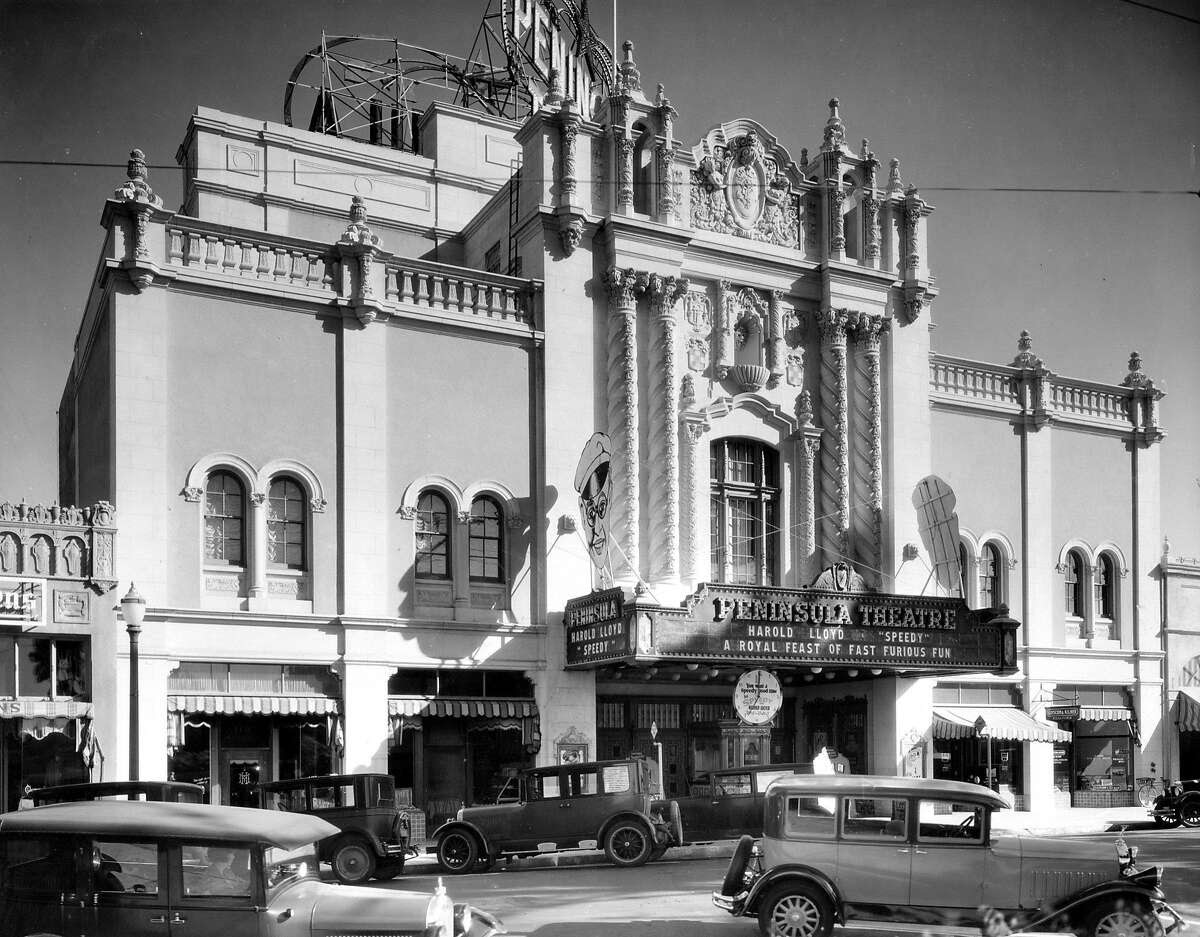 The Peninsula Theatre in Burlingame on October 4, 1930, courtesy of Gabriel Moulin.
The Peninsula Theatre in Burlingame on October 4, 1930, courtesy of Gabriel Moulin.Burlingame
There’s some debate over land ownership and property acquisition, but the provenance of Burlingame undoubtedly comes from Anson Burlingame. Burlingame was a lawyer and politician, serving as President Lincoln’s minister to the Qing Empire in China. It’s speculated that the politician bought a large estate in the Bay Area after visiting friend William C. Ralston’s manor in Belmont.
Campbell
No complicated explanations here: Campbell is named after its founder, Benjamin Campbell. Campbell brought his family west in 1846 and purchased 160 acres in today’s downtown Campbell to seed with hay and grain.
Concord
Formerly called Todos Santos, its 1869 change to Concord was deeply contentious. The 1869 Contra Costa Gazette ran both points of view. Proponents of Concord said “for significance and euphony no finer designation could have been found.” Opponents, like town leader Fernando Pacheco, urged businessmen to “please remember its name [Todos Santos] … for in fact the town of ‘Concord’ does not exist.” Concord won out, adopted officially when the town was incorporated in 1905.
Cupertino
When the town was looking to pick its official name in 1898, they chose to name it after nearby Cupertino Creek. The creek, in turn, had been named by Franciscan priests after Saint Joseph of Cupertino. Joseph was said to be “remarkably unclever” but was able to levitate, a claim that modern historians take serious umbrage to. Some think he was very good at gymnastics. Others think he suffered from ergot poisoning. In any case, he’s the patron saint of air travelers, poor students, astronauts and the namesake of Cupertino.
Daly City
By the time 13-year-old John Daly arrived in California in the 1850s, life seemed grim. His mother had died on the Panama crossing, and young Daly was forced to find work on a dairy farm in San Mateo County. But Daly, bright and kind by all accounts, rose quickly. By 1868, he owned 250 acres on the “top-of-the-hill.” When San Francisco’s streetcars extended over that hill, the stop became known as Daly’s Hill. Daly helped house and feed 1906 earthquake refugees and when the town incorporated in 1911, the town was named in his honor.
Dublin
Irish immigrants flocked to this spot in Alameda County. By the 1870s, the township was full of Irish names: Fallon, Donlan, Dougherty and more. According to local lore, early settler James Witt Dougherty once said, “There are so many Irish here, you might as well call it Dublin.” Whatever its origin, the name stuck.
El Cerrito
El Cerrito came into existence because of the 1906 earthquake and fire. San Franciscans fleeing the destruction set up a refugee camp, which evolved into a full-fledged town. It was initially named Rust after the town’s first postmaster, but residents changed it to El Cerrito in 1916, a word that means knoll in Spanish.
Emeryville
As you could guess, Emeryville gets its name from a Mr. Emery. Joseph Stickney Emery arrived in California during the Gold Rush and became president of the California and Nevada Railroad. He owned large land tracts called “Emery’s” by locals. The town took his name when it incorporated in 1896.
Fairfield
When the Mexican land grant Rancho Suisun came into the hands of clipper ship captain Robert Waterman in the mid-1850s, he decided to parcel out the town and rename it. He picked Fairfield in honor of his hometown, Fairfield, Conn. The nearby town of Cordelia was named for his wife.
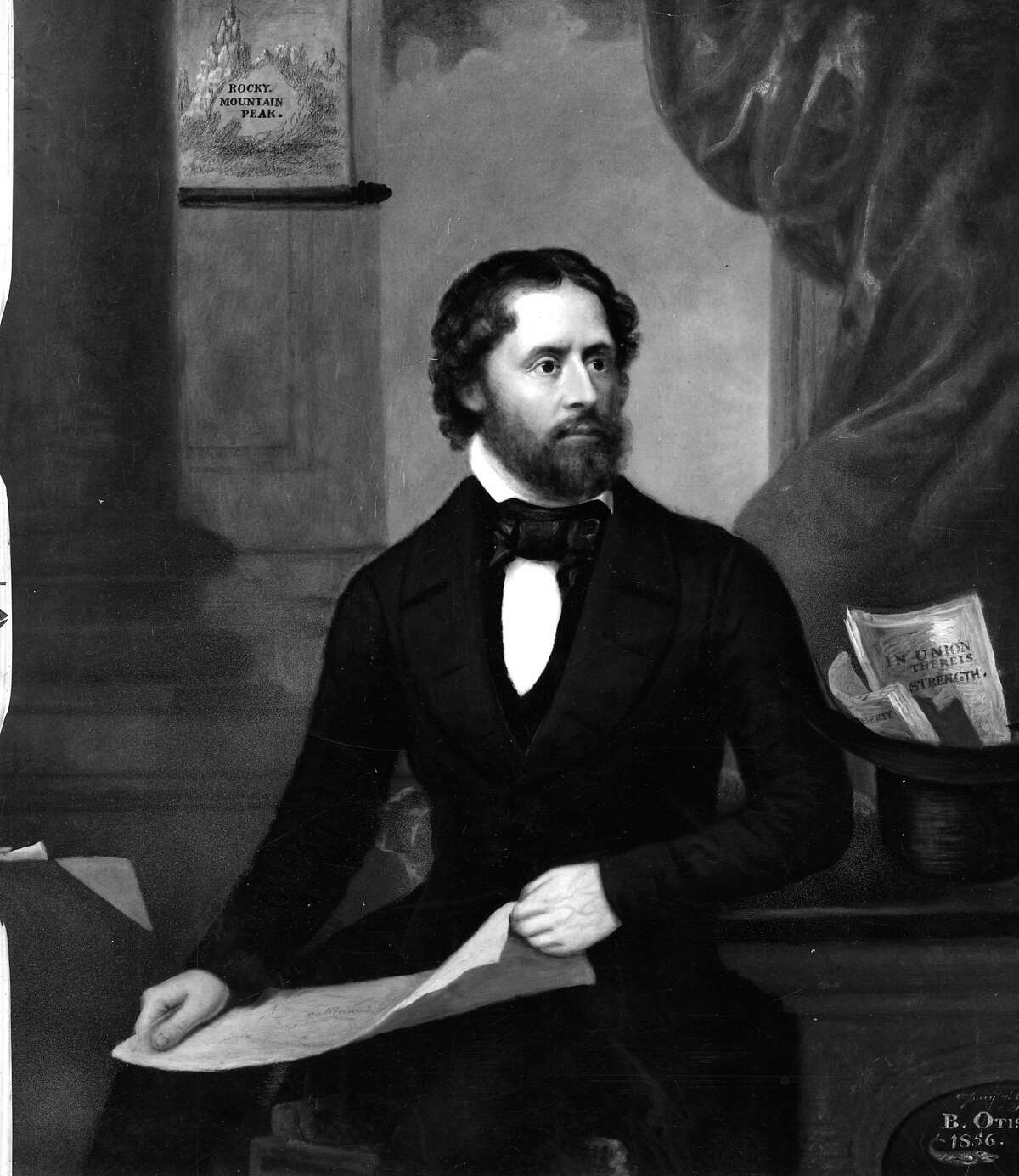 John C. Fremont. Courtesy of National Portrait Gallery street names project.
John C. Fremont. Courtesy of National Portrait Gallery street names project.Fremont
You probably remember this guy from your elementary school history classes: John C. Fremont. The California explorer and politician — he ran for president in 1856 as the first-ever candidate from the new Republican Party — mapped part of the area during his 1846 survey of the region.
Gilroy
John Gilroy, who gave his name to the town, was an interesting guy — and not actually named John Gilroy. John Cameron was a Scottish sailor who arrived in California in 1814 and jumped ship around the Monterey area. He changed his name to Gilroy, and lived among the natives and Mexican settlers as one of just two English speakers in Alta California. He married a ranchero’s daughter, and the Gilroy settlement evolved around their land.
Half Moon Bay
This one’s pretty self-explanatory. In 1874, the residents of “Spanishtown,” so-called because of its many Spanish speakers, elected to change their town name to Half Moon Bay. It’s a nod to the half-moon-shaped harbor in town. From one descriptive name to another.
Hayward
Travelers between Oakland and San Jose in the 1850s likely all knew of the Haywards Hotel and general store. Opened by William Hayward in 1852 after his stint as a prospector failed, the inn was a famous stop on the route between the cities. When the town was incorporated in 1876, the name Haywards was chosen. The ‘s’ was dropped shortly thereafter.
Hercules
Hercules’ name is — excuse the pun — quite explosive. In 1881, the California Powder Works company starting producing dynamite and black powder. It was sold as Hercules Powder, a marketing ploy meant to show off the dynamite’s potency. When the town was incorporated in 1900, the community leaders, who also worked as the plant managers, chose Hercules as the city name.
Lafayette
Lafayette went through quite a few iterations before settling on its current name. It was, at varying times, known as Dog Town, Brown’s Corner, Centerville and Acalanus, the name of the original Mexican land grant. When Benjamin Shreve became the town’s first postmaster in 1857, he favored Centerville. But, as it was already taken by another California town, he went with his second choice, La Fayette.

The Golden Hills Wind farm between Livermore and Tracy.
Steve Proehl/Getty ImagesLivermore
Like John Gilroy, Robert Livermore found fame after jumping ship near Monterey. The English sailor arrived in California in 1822 and partnered with local Jose Noriega to raise stock and grain. Livermore eventually bought out Noriega’s share in the land grant and passed on the ranch to his children. When the city was founded in 1869, it took Livermore’s name.

This picture taken from a helicopter shows Los Altos Hills.
JEWEL SAMAD/AFP/Getty ImagesLos Altos
The name’s no big secret: “the heights” refer to Los Altos’ lofty position in comparison to its neighboring cities. But did you know that the land that comprises Los Altos once belonged to Sarah Winchester? The eccentric Winchester rifle heiress sold the land to the Southern Pacific Railroad in 1906, which selected Los Altos as its name.
Los Gatos
A cat lover’s dream, Los Gatos was named for the many cougars and bobcats that Spanish-speaker settlers found lived in the foothills in the 1800s.
Martinez
It paid to be the commander of the Presidio. Don Ygnacio Martinez, comandante of San Francisco’s garrison, was gifted a 17,000-acre land grant by the Mexican government in 1824. In 1849, part of that land was named Martinez in his honor.
Menlo Park
When Irish immigrants Dennis J. Oliver and D. C. McGlynn arrived in the Bay Area, they purchased a 1,700-acre Spanish land grant in today’s Menlo Park. Reminiscing about home, they decided to name the area Menlo Park, a tribute to Menlo in Galway, Ireland.
Millbrae
When Bank of California founder Darius Ogden Mills decided to build his 42-room mansion, he picked a plot of land outside of San Francisco and called it Millbrae — a combination of his name and the Scottish word for hill. Millbrae the mansion burned down in 1954, but the name lived on.
Mill Valley
Another self-explanatory name here: Mill Valley gets its name from the Old Mill built by John Thomas Reed, Marin’s first Anglo-Saxon settler. Reed built the saw mill in the 1830s to process lumber for the Presidio.
Milpitas
If you guessed Milpitas is a Spanish word, you’re almost right. The city’s name comes from “milpa,” a Nahuatl word that means “place where corn grows.” Mexican settlers adopted the word and made it into a diminutive (milpitas) to refer to Native American gardens. They also named a large land grant Rancho Milpitas, which then became modern day Milpitas.
Morgan Hill
Morgan Hill has nothing to do with hills: It’s a man’s name. Diana Murphy, the daughter of a prominent local landowner in the 1800s, wed a man named Hiram Morgan Hill in 1882. Diana inherited 4,500 acres from her family, and the pair named their estate the Morgan Hill Ranch. When the city incorporated in 1906, they took the name of their most famous landmark.
Napa
No one’s quite sure where the wine region got its name from, although most historians agree it’s probably an anglicized word from the local Wappo tribe. Speculation runs the gamut as to what Napa means — some say fish, others village, and still others grizzly bear. In maps from the 1840s, the city is spelled ‘Nappa.’
Newark
No, California’s Newark isn’t named for its New Jersey counterpart. The name was chosen by J. Barr Robertson, a Scotsman who in the late 1800s was managing the land that today comprises Newark. He took his inspiration from Newark Castle in Port Glasgow, Scotland.
Novato
The Marin County city took its name from a local Miwok leader. Historians believe his name, Novato, was given at baptism by Mexican priests in honor of Saint Novatus.
Oakland
There’s no fancy tale to how Oakland got its name. Part of the area used to be called ‘Encinal,’ the Spanish word for oak grove — of which there were many. And that became Oakland as English-speaking settlers developed the area.
Orinda
Orinda breaks with the Spanish naming scheme theme of much of the Bay Area and sports the name of a 17th century English poet. Katherine Fowler Philips was a favorite poet of Alice Mars Camron, the wife of the town’s sheriff in 1876. Philips was called the “Matchless Orinda,” and from that, Camron chose the name Orinda for her family home. The area was officially named Orinda in the 1920s.
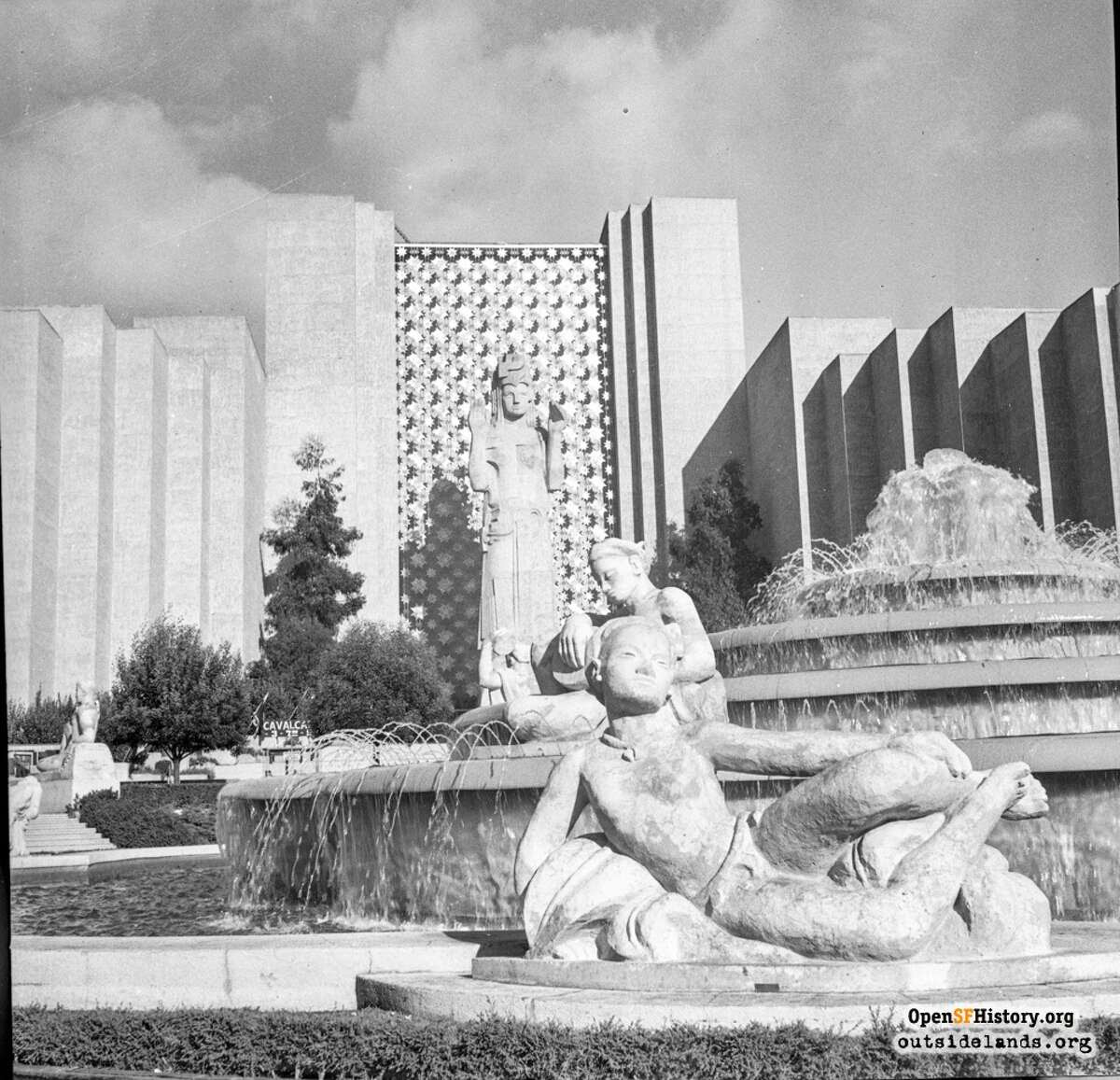
A view of the Golden Gate International Exposition on Treasure Island, courtesy of OpenSFHistory.org.
Courtesy of OpenSFHistory.orgPacifica
Pacifica’s name might seem intuitive (it is), but it wasn’t given its name until 1957 when the city held a naming contest. The winner came from a statue: Pacifica was the title of an 80-foot statue created for the Golden Gate International Exposition. The original statue no longer exists, but working models are on display at city hall and the city council chambers. Photo courtesy of OpenSFHistory.org.

El Palo Alto, the namesake tree of Palo Alto, Calif.
Wikimedia Commons/Public domainPalo Alto
Palo Alto gets its name from one famous tree: El Palo Alto. The redwood tree, whose name means “the tall tree,” is over 1,000 years old and is California State Landmark No. 2. When the city incorporated in 1894, it took the name of its most famous resident: the tree.
Petaluma
Petaluma may sound like another Spanish name, but historians believe it’s a word from the Coast Miwok tribe. The Miwok village that is today Petaluma was called Péta Lúuma. It likely means “hillside ridge,” a reference to Petaluma’s location near Sonoma Mountain.
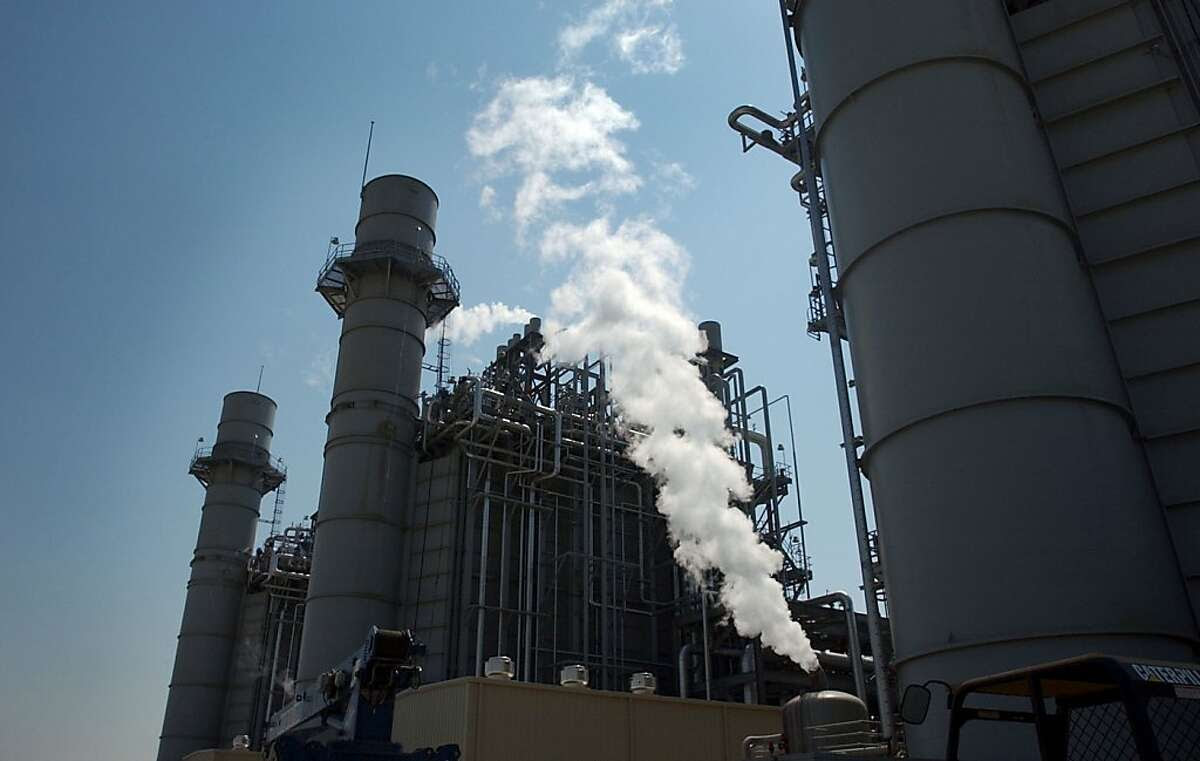
The Calpine-Delta Energy Center electric power plant in Pittsburg is one of the two power plants in the city.
Jakub Mosur/APPittsburg
Pittsburg boomed after the discovery of coal nearby in the 1800s, and residents voted to name their town after a similar industrial city, Pittsburgh, Pennsylvania. But their timing created the spelling difference that persists today. Pennsylvania’s Pittsburgh was spelled without an ‘h’ from 1891-1911 after the United States Board on Geographic Names tried to standardize spellings nationwide. After two decades of appeals, however, Pennsylvania won the right to spell their city’s name with an 'h.' And California’s Pittsburg stayed without it.
Pleasant Hill
One of the newer cities on the list, Pleasant Hill's name origin is tougher to ascertain. The region was subdivided for housing in the 1920s and didn't officially get a post office until 1948. When it incorporated in 1961, it took the name Pleasant Hill, but even the city's official history makes no mention of where it got its name. So perhaps it's safe to assume that people found the area both pleasant and hilly and went with the obvious.
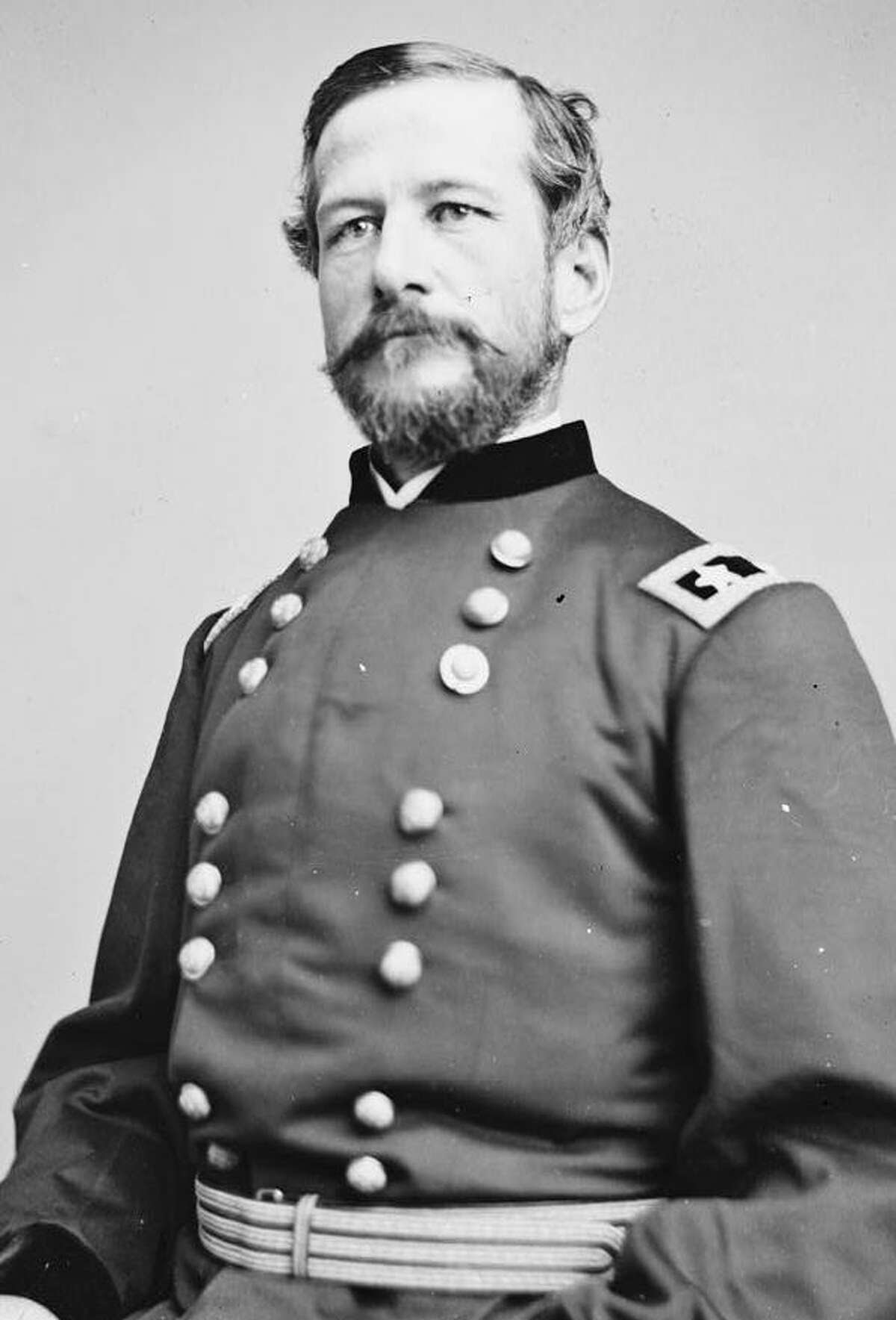
Portrait of Maj. Gen. Alfred Pleasonton, officer of the Federal Army and Union army general. He gave his name to Pleasanton, Calif.
Library of Congress Prints & Photographs DivisionPleasanton
Believe it or not, Pleasanton isn’t a reference to pleasant living. It’s actually someone’s name. The city was named for General Alfred Pleasonton, a commander of the Army of the Potomac during the Civil War. Due to a spelling mistake by a U.S. Postal Service worker, the town became Pleasanton.
Point Reyes
Point Reyes has had its current name for centuries. When Spanish explorer Sebastian Vizcaino landed in Drakes Bay on Jan. 6, 1603, it was the Day of the Three Kings. In honor of Epiphany, he called the spot Kings’ Point, or Point Reyes.
Redwood City
You guessed it; it’s because of redwoods. The waterfront was called Embarcadero initially, but residents didn’t love it. They changed the name to Redwood City due to the large number of redwood lumber shipments that came into the area.
Richmond
When California’s first legislature met in 1849, one of the representatives was Edmund Randolph. Randolph became a state assemblyman and he used his clout to convince the federal survey team to include a Richmond — the town of his birth in Virginia — in their 1854 map.
Rohnert Park
Rohnert Park was long an agricultural center, and the farmland switched hands often in the early 1900s. In 1929, a large ranch was sold to Waldo Emerson Rohnert, a Detroit native. Rohnert did well, planting the largest prune orchards on the West Coast and expanding his business. When the town incorporated in 1954, the name Rohnert Park was selected.
San Bruno
This one involves a bit of narcissism. Captain Bruno Heceta, an early explorer of the region, came ashore in 1775. He decided to name the mountain, creek and the area San Bruno, after his patron saint (and himself, of course). Saint Bruno the Confessor founded the Carthusian Order and is the patron saint of possessed people.
San Carlos
There’s some dispute as to who gave their name to San Carlos. The most popular explanation is that it was named after the San Carlos, a sailing ship that carried Juan Manuel de Ayala into the San Francisco Bay in 1775. Other candidates include King Charles III of Spain or that the Portola Expedition encountered the spot on the day of the Feast of St. Charles in 1769.
 The San Francisco skyline.
The San Francisco skyline.San Francisco
As you probably already know, San Francisco was originally named Yerba Buena in the 1700s by Spanish-speaking explorers. The name was officially changed to San Francisco in 1847 by Washington Bartlett, the first American mayor of Yerba Buena. Its namesake was Mission San Francisco de Asis, or Mission Dolores, which was dedicated in honor of St. Francis.
San Jose
Few missions were are large and significant as the Mission San Jose, whose lands stretched from Oakland to San Jose. La Mision del Gloriosisimo Patriarch San Jose was named for Saint Joseph. The city was later named for Saint Joseph, too.
San Leandro
Like in many other parts of California, Franciscan priests utilized native labor to establish mission communities. The Ohlone were recruited (willingly and by force) to take care of the cattle herds from Mission San Jose. The farmland was called el Rodeo de Arroyo de San Leandro, a name that was later shortened when the city incorporated in 1872.
San Mateo
Spanish colonists established the Rancho San Mateo in honor of Saint Matthew, naturally, in the late 1700s. When English explorers arrived in the 1800s, they noted the area was called San Mateo and belonged to the mission of San Francisco.
San Rafael
San Rafael takes its name from Mission San Rafael Arcangel, a Catholic hospital built in 1817. The mission was intended to provide refuge to sick Native Americans who needed to escape the colder climes of San Francisco.
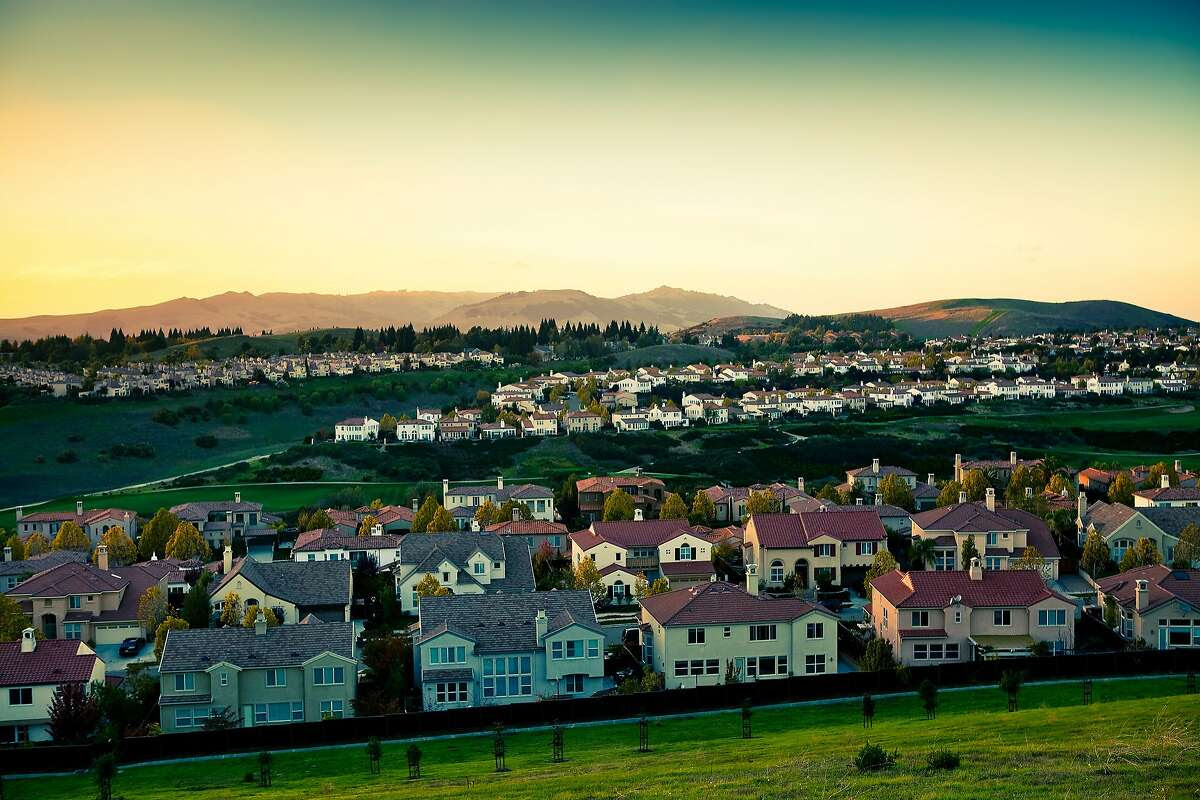 Identical houses on cul-de-sac streets line the hills of San Ramon, a bedroom community 50 miles east of San Francisco.Getty Images
Identical houses on cul-de-sac streets line the hills of San Ramon, a bedroom community 50 miles east of San Francisco.Getty ImagesSan Ramon
No saints here: San Ramon is simply named after a farmer named Ramon. The Mission San Jose shepherd, named Ramon, lent his name to a nearby creek. The “San” was added to keep the area in line with the usual Spanish naming conventions.
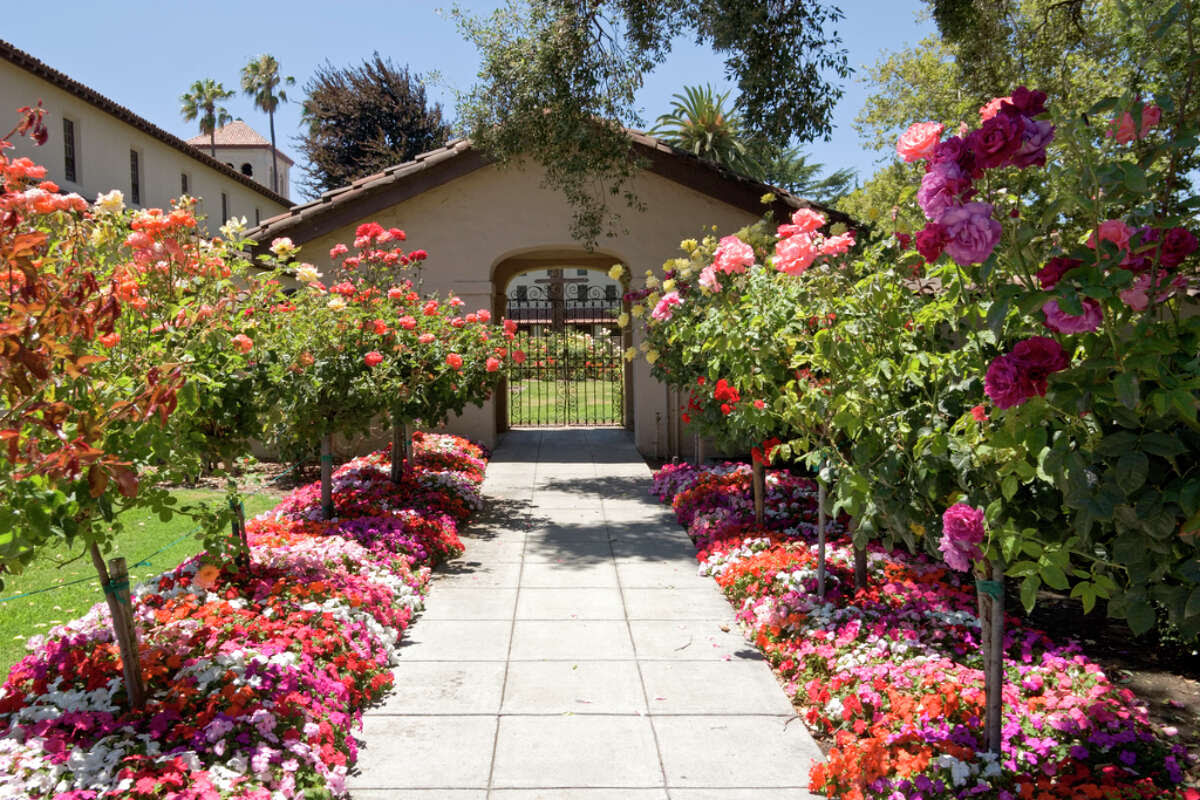
Mission Santa Clara de Asis, built in 1777.
Richard WongSanta Clara
If you’ve figured out California’s mission-themed naming scheme, you already know why Santa Clara has its name. The Mission Santa Clara, the eighth in the mission system, was established in 1777 and named for Saint Clare of Assisi, an early follower of Saint Francis.
Santa Rosa
City legend holds that a young Native American woman was baptized in a local stream on the day of the Feast of Santa Rosa de Lima. The girl, the stream and, later, the town all took the name Santa Rosa.
Saratoga
You probably guessed the New York connection here. When settlers discovered a mineral spring there in the 1860s, it reminded them of Congress Spring in Saratoga Springs, New York. And thus Saratoga, the tony resort town, was born.
Sonoma
Calling Sonoma the “Valley of the Moon” is a bit redundant; that’s exactly what Sonoma means. The name was bestowed upon the area by the local Miwoks and adopted when Spanish explorers established the Mission San Francisco Solano in 1823.
South San Francisco
Sure, the name makes good geographic sense. But did you know that South San Francisco has its origins in a massive meat packing operation? Meat packers and butchers from Omaha bought land there in the late 1800s, intended to create a West Coast stockyard. They called it the South San Francisco Land and Improvement Company.

Sunnyvale, California, May 23, 2014.
Justin SullivanSunnyvale
For much of its early history, Sunnyvale was known as Murphy thanks to Martin Murphy, a pioneer who settled in the region in the 1840s. Early advertisements called the town “Beautiful Murphy,” but when the Murphyites tried to open their post office in 1901, they were told the name was already taken. They settled on Sunnyvale instead.
Union City
This one sounds Civil War-related, but it’s not. Union City got its name from ‘The Union,’ a steamboat owned by settlers John and William Horner. The Horners built up the settlement in the wake of the Gold Rush. John Horner also went on to found today’s Noe Valley neighborhood of San Francisco.
Vacaville
It’s not a preponderance of cows that gave Vacaville its name. The city was created from land once owned by Manuel Vaca. When Vaca sold the land in the 1840s, he did so under the condition that one square mile be called “Vacaville.” By 1851, the entire township had taken his name.
 General Mariano Guadalupe Vallejo
General Mariano Guadalupe VallejoVallejo
Here’s another name you should remember from California history: Mariano Vallejo. The Monterey-born general at varying times was commander of the Presidio, creator of the town of Sonoma and political prisoner of John C. Fremont during the Bear Flag Revolt. Vallejo proposed the creation of a town named Eureka as the state capitol in 1850 and the proposal was accepted — but the town’s name was changed to honor Vallejo instead. Vallejo didn’t construct a building to house the state capitol, however, and sessions were soon moved to Sacramento.
Walnut Creek
Residents of Walnut Creek will be happy to learn that they aren’t called Nuts Creek anymore. The spot in Ygnacio Valley was originally called Arroyo de las Nueces, which Gold Rush settlers called Nuts Creek upon their arrival. The name was refined a bit by Milo Hough, who opened the Walnut Creek House hotel in 1855. In 1862, the town officially took the name Walnut Creek.

